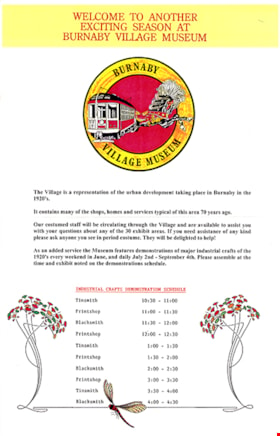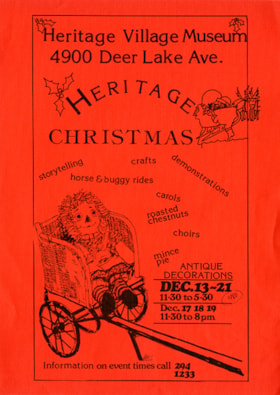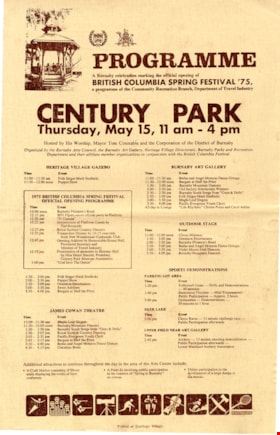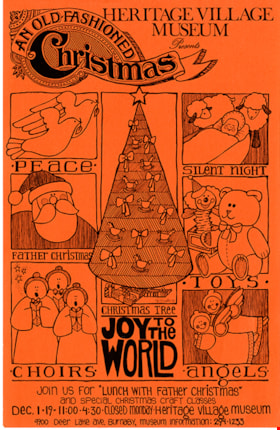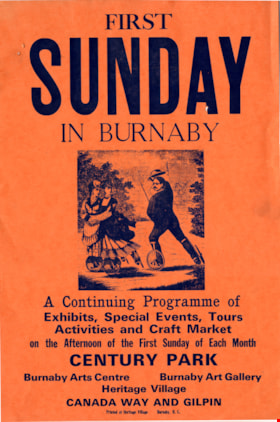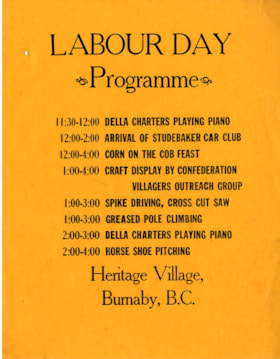Narrow Results By
Interview with Surjeet Kaur Parmar
https://search.heritageburnaby.ca/link/museumdescription19350
- Repository
- Burnaby Village Museum
- Date
- [1905-2022] (interview content), interviewed 6 Dec. 2022
- Collection/Fonds
- Burnaby Village Museum fonds
- Description Level
- Item
- Physical Description
- 2 sound recordings (wav) (75 min., 32 sec.) + 1 sound recording (mp3) (75 min., 32 sec.)
- Scope and Content
- Item consists of a recording of an oral history interview with Surjeet Kaur Parmar conducted by interviewer Anushay Malik. The interview is conducted in Urdu, Hindi and Punjabi. During the interview Surjeet Kaur Parmar provides information on; her ancestral background, family relations in India and…
- Repository
- Burnaby Village Museum
- Collection/Fonds
- Burnaby Village Museum fonds
- Series
- Museum Oral Histories series
- Description Level
- Item
- Physical Description
- 2 sound recordings (wav) (75 min., 32 sec.) + 1 sound recording (mp3) (75 min., 32 sec.)
- Material Details
- Interviewer: Anushay Malik Interviewee: Surjeet Kaur Parmar Language of Interview: Urdu, Hindi and Punjabi Location of Interview: home of Surjeet Kaur Parmar in Burnaby Interview Date: December 6, 2022 Total Number of tracks: 2 Total Length of tracks: (1:15:32) Digital master recordings (wav) were edited into one recording and converted to mp3 for access on Heritage Burnaby
- Scope and Content
- Item consists of a recording of an oral history interview with Surjeet Kaur Parmar conducted by interviewer Anushay Malik. The interview is conducted in Urdu, Hindi and Punjabi. During the interview Surjeet Kaur Parmar provides information on; her ancestral background, family relations in India and Canada, her personal experiences and her ancestors’ stories as South Asian immigrants, reflections on and personal experiences of racial discrimination as a South Asian immigrant, her places of residence, her employment background, her cultural practices and traditions including food, clothing and craft. The interview begins with introductions from interviewer Anushay Mailik. Surjeet Kaur Parmar imparts her own family’s migration story beginning with her very first elders that immigrated to Canada from India. A relative (unnamed) immigrated to Canada first and a few years later (around 1905) returned to India and brought back three cousins that included; Ginaya Singh (Ghania Singh Manhas) and Doman Singh . Mayo Singh (Ghania Singh’s younger brother) came in 1906 on his own to join them. Surjeet’s grandfather (Shair/Sher Singh Manhas) also wanted to immigrate at this time, but he was too young and weak to manage such a long trip. Surjeet conveys that while living in British Columbia, Mayo and Ginaya Singh worked together at saw mills. With their knowledge and understanding of mill work they ended up owning and operating a mill in Paldi near Duncan on Vancouver Island. At this time, most of the men from Surjeet’s family region in Punjab were abroad and with no men living at home. Mayo Singh’s father (Bhulla Singh) looked after her father (Lashman Singh Manhas) and paternal uncle (Kashmir Singh Manhas) back in Punjab. When Mayo’s father died, Mayo Singh adopted her paternal uncle (Kashmir Singh) and brought him to Canada in 1926. Surjeet describes her ancestors’ immigration journey from India to Canada. They all travelled by ship and if someone ran out of money en route, they could work on the ship. Surjeet explains that both Mayo and Ginaya Singh are Surjeet’s grandfather’s first cousins and her father’s second cousins. Surjeet recollects her grandfather (Shair/Sher Singh Manhas) saying “now that you’ve arrived there, take one cousin from each side with you”. Surjeet explains that the cousins were all from the same village in Punjab and her great grandfather wanted someone to go abroad, so he sent a few and had them bring more as the years went on. Surjeet says that she’s uncertain as to why they chose Canada rather than America but thinks that they did some form of research and determined that it was a good place to come to. Surjeet admits that she doesn’t know the name of her paternal grandfather or other elders since she never met them. Surjeet shares that it was a traditional practice to mark pots and pans with family names and imparts that she discovered her father’s name “Lashman Singh” written on the bottom of a glass. Surjeet expresses that she’s marked her own pots and pans with her name to identify which ones are hers when she gets together with family or does catering. Surjeet refers to a kohl bottle that she has and how she’d like to offer it to the museum. She explains how the kohl bottle is no longer in use but was used by her mother (Budhan Kaur Manhas) and daughter and her grandchildren. Surjeet describes a blanket that she made called a “phulkari”, now on display in a small museum in Coquitlam, a wedding shawl, that her daughter now owns and a silk sari with embroidery. Surjeet and Anushay discuss the possibility of donating the kohl bottle and the sari to the museum. Surjeet explains how the kohl is used and how her mother used to make kohl. She describes how you rub the kohl with your hands, put cardamom in it, one or two other ingredients and fill the kohl bottle up with water. Surjeet says that she used kohl as eyeliner when living in India. The interviewer asks Surjeet more about Ginaya Singh. Surjeet conveys that Ginaya Singh ended up leaving the mill on Vancouver Island and moved to Vancouver. After Ginaya Singh died from a heart attack (in 1953) his family moved from Vancouver to Burnaby. Surjeet recalls that following the death of Ginaya Singh’s youngest son, her family didn’t celebrate “Lohri” (a winter festival celebrating newborns and newly married people) for three years. She shares that she was very young at this time but remembers there being beautiful photographs of young children all dressed up and displayed in her family home. She expresses that dressing up for photos has changed over time and adds that suits didn’t really come into fashion until after the 1970s or 1980s. Surjeet conveys that her uncle named Kashmira Singh first worked at the mill in Paldi near Duncan then moved to Vancouver and opened up his own mill in North Vancouver. Surjeet’s father, Lashman Singh Manhas arrived in 1953. Surjeet expresses that Kapoor Singh was educated and worked as a manager at the mill on Vancouver Island. Surjeet recollects meeting Mayo Singh, his wife and eldest son in 1952 when they travelled to India for a cousin’s wedding. Surjeet remembers that Mayo Singh’s family had a very large house in India. She describes the house as a very opulent two story house with indoor plumbing for a bathtub, a kitchen with a woodstove, coloured mirrors, bejeweled curtains, a motor room to park cars, a buffalo and more. Surjeet refers to Nand Singh, a younger brother of Mayo Singh, who travelled from India to San Franciso and spent a year wandering around before deciding to return to India. She describes him as living in Bombay with his wife Vishan Kaur and having a transport business. Nand had two kids that came to Canada. Surjeet recollects the tragic death of Ganda Singh (Ginaya Singh) who died of a heart attack on someone’s doorstep, they thought that he was drunk so didn’t open the door. Surjeet conveys that Mayo Singh’s wife, Mission Kaur (Saradani Bishan Kaur) died while visiting India (in 1952) and that some of Mayo’s sons were married in Canada and one in India. Surjeet expresses that it was hard for Mayo’s sons to have one of their parents die in India and one die in Canada (Mayo Singh died in B.C. in 1955). Surjeet describes the hospital that Mayo built in the village of Paldi. She mentions that there were festivals and functions that took place there, there were many nurses and doctors. She recalls there being a school where their land was. She recalls that if they got headaches they were treated with medicine and that it didn’t cost much, only a six pence. Surjeet talks about her arranged marriage to Kalwant Singh "Nadeem" Parmar. Surjeet explains that her father and brother immigrated to British Columbia first (1953) and after a few months they brought Surjeet and her mother (Budhan Kaur Manhas). She recollects that when she was in Grade 10 and around 17 years of age, her family made plans to travel to India to attend a family wedding. During this time, her father suggested that it would be a good opportunity to take Surjeet with them to find her a husband in India to marry. After meeting and marrying Nadeem Parmar in India, Surjeet and Nadeem moved to England. Surjeet recollects that in order to immigrate to Canada, each family member had to pass a medical exam and how difficult it was. Her two sisters, mother and brother all had to take the test in Delhi. Surjeet recalls living in England with Nadeem. While living in England, Nadeem worked during the day and studied engineering at college in the evening. Surjeet expresses that she liked living in England and was sad to leave. While living there, they enjoyed a close knit Punjabi community and they all lived in the same area. Surjeet states later in her interview that living in Canada was different from living in England. In England, family and friends lived closer together whereas in Canada places were further apart. Surjeet says that while living in England she could walk to do her shopping. While living in England, after her children were a bit older, she worked as a seamstress in a shirt factory for a few years before coming to Canada. Surjeet imparts that her father (Lashman Singh Manhas) died of a heart attack in 1970 and her mother (Budhan Kaur Manhas) died in 1998. Her father and her family first lived in North Vancouver and then her parents bought a house on Eton Street in Burnaby, near the Ocean. After her father died, her brother and mother bought a house and moved to the Capitol Hill neighbourhood in Burnaby. In 1973, Surjeet, Nadeem and their two children immigrated to Canada and moved in with her brother and mother. Surjeet includes that her paternal aunt (Koshali Kaur Manhas) and cousins also moved to Burnaby and that her aunt and some of her cousins were sponsored by her son who came earlier. Surjeet recalls that after arriving in Canada she got work sewing in a factory located on Water Street in Gastown. Surjeet recollects travelling to her job by bus. Surjeet shares that she brought saris and quilted blankets “rijai”, not household items, in her suitcase when she came to Canada from England. Surjeet explains that the “rijai” (quilted blankets) were made from cotton from her home village in India. The blankets were made by women and then brought back to her to quilt on her sewing machine. Surjeet recalls that when she returned to Canada (in 1973 with her husband and children) they first lived with her mother and brother on Capitol Hill in Burnaby before moving to a house on Fell Avenue and then to their current home in 1982. In 1981, she worked at “Canadian Window Covering” factory making window coverings. The factory was located in the Brentwood area of Burnaby. Surjeet recalls how the factory became unionized and of how she left the factory and found union work at the Labatt’s brewery (Winery and Distillery Workers Local 300). Surjeet describes the work that she did while working at Labatt’s brewery which was located next to the Royal Columbian Hospital in Burnaby. Around 1995, when the Labatt’s factory closed down in Burnaby, she got union work as a bottle sorter for BDL Brewers Distributor Limited, where bottles were gathered for distribution at Braid Station. Surjeet left this job in 2000. Surjeet talks about traditional foods like bindi, sabji, aam and karela and where she’s shopped to find traditional ingredients for South Asian cuisine. She recollects how at first she could only find traditional ingredients at stores in Gastown, Chinatown and on Main Street in Vancouver but now they are more readily available at major grocery stores. Surjeet expresses that traditional spices and dry goods have been hard to find, apart from stores like, Famous Foods and Patels when it was located on Commercial Drive. Surjeet talks about using ingredients such as green pea flour and Besan flour to make pakoras and kahdri. Surjeet states that many immigrants didn’t wear their traditional clothing until she came later. She expresses that many South Asian immigrants didn’t wear their clothes “because there were no rights, we had to try to become like them”. Surjeet conveys that even though some were able to purchase property (she provides an example of family members in Duncan who faced discrimination by the owner/seller of a piece of property they were purchasing) that they had very little rights and they were all living in fear. She expresses that she herself didn’t experience this but in the beginning when people settled here (in B.C.) that it was very difficult. Surjeet says that when she goes to the Gurdwara and to work, she wears a sari and conveys that while working at the factory, she was encouraged to wear a sari, it was accepted then. She brought printed saris to work and her co workers said that they’d wear them to parties. Surjeet reflects on her own experiences of racism and discrimination and expresses that her generation “has learned how to stand up in front, then they got scared of saying anything”. “The people who came here first were afraid because they were alone, they had to settle down here and make a home from scratch, but the ones who came after had everything already built and made”. She explains how they helped one another when they came (to British Columbia). She describes how the Gurdwara was located on 2nd Street and all of the ships went there (new immigrants?), people would gather, get water, help one another and there would be a place for all people. Surjeet shares a personal experience of helping members of her husband’s family to immigrate to Canada. She tells of the complications of some being left behind in India and that some came to Canada as refugees that she and her husband sponsored. Surjeet expresses their struggles with raising a family, working and trying to pay for their own house while also trying to assist and support family members. Surjeet describes in detail how her husband Nadeem went back to India after his mother died to help his father, sister and her family immigrate. She explains that the immigration process took about four years and his father had to apply as a refugee. Nadeem’s sister came with her children but had to return to India so Surjeet and her family had to look after Nadeem’s sister’s child/children. Surjeet expresses that during this time she continued to work at Canadian Window Coverings, working an afternoon shift and sometimes taking her son with her. She expresses that this as a very hectic time, working the whole day, making food for everyone, grocery shopping, looking after a her sister in law’s younger child at night and getting no rest. Surjeet describes the time when she was working and her children were attending the local school. She expresses the challenges of working long days and often arriving home after her children. She recollects a time when there was a snow storm and how she was worried about her children making it home and being alone while she was at work, there were no cell phones in those days but they had phone numbers of her brother and sister. Surjeet tells of how they tried to help the rest of the Nadeem’s family immigrate including his brother who was a soccer player in India. They were able to buy a house for the whole family to live but expresses after several months Nadeem’s brother decided to stay in India. Surjeet expresses the complications and frustrations of trying to bring all family members to Canada.
- History
- Interviewee biography: Surjeet Kaur Parmar was born in Punjab, India in 1942 to parents Lashman Singh Manhas (1913-1970) and Budhan Kaur Manhas (1906-1998). Surjeet’s ancestors, Ghania Singh Manhas, Doman Singh and Mayo Singh immigrated to British Columbia in 1905 and 1906. The group got work in saw mills and soon began owning and operating their own saw mills, first in Chilliwack and Rosedale districts and later in 1920 on Vancouver Island near Duncan (Paldi) (known as the Mayo Lumber Company). In 1927, Surjeet’s paternal uncle, Kashmir Singh Manhas left Paldi, Punjab at the age of 18 years with Mayo Singh Manhas and after months of travel they arrived at Paldi on Vancouver Island. In 1953, Surjeet’s father, Lashman Singh Manhas and her two brothers immigrated to Canada and soon after brought her and her mother, Budhan Kaur Manhas. After immigrating, her father began working at “Kashmir Lumber Company” in North Vancouver which was owned by his brother Kashmira Singh Manhas. Surjeet, her parents and two brothers first made their home in North Vancouver and the 1960s they moved to 3824 Eton Street in Burnaby. In 1959, Surjeet and her family returned to India for her brother’s wedding. During this time a marriage was arranged for Surjeet to marry Nadeem Parmar and they were married in 1960. Following their marriage, Surjeet and Nadeem moved to England where they began raising their two children. While living in England, Surjeet worked as seamstress at a factory. In 1973, following the death of Surjeet’s father who died in 1970, Surjeet and Nadeem decided to immigrate to British Columbia. For the first few years, Surjeet, Nadeem and their two children lived with her mother and brother in the Capitol Hill neighbourhood of Burnaby before purchasing their own home on Fell Avenue. While living in Burnaby Surjeet has worked as a seamstress for Canadian Window Covering, Labatt's Brewery and BDL Brewers Distributor Limited which she left in 2000. In 1982, Surjeet and her family moved into a new home that they had built on Woodsworth Street where they still live today. Interviewer biography: Anushay Malik is labor historian with a geographical focus on South Asia. Anushay studied at the University of London and was a research fellow at the International Institute of Social History in Amsterdam, Netherlands. In 2014, Anushay moved back to her native Pakistan and joined Lahore University of Management Services as an Assistant Professor. In 2023, Anushay is a visiting scholar at Simon Fraser University and lives in Burnaby with her family. Anushay was a co-curator of the Burnaby Village Museum exhibit “Truths Not Often Told: Being South Asian in Burnaby”.
- Creator
- Burnaby Village Museum
- Subjects
- Buildings - Industrial - Saw Mills
- Clothing
- Crafts
- Employment
- Migration
- Social Issues
- Social Issues - Racism
- Occupations - Labourers
- Occupations - Millworkers
- Persons - South Asian Canadians
- Names
- Parmar, Surjeet Kaur
- Parmar, Kalwant Singh "Nadeem"
- Manhas, Ghania Singh
- Singh, Mayo
- Manhas, Kashmir Singh
- Manhas, Sher Singh
- Manhas, Budhan Kaur
- Manhas, Lashman Singh
- Accession Code
- BV022.29.5
- Access Restriction
- No restrictions
- Reproduction Restriction
- No known restrictions
- Date
- [1905-2022] (interview content), interviewed 6 Dec. 2022
- Media Type
- Sound Recording
- Related Material
- See also BV022.29.1 - interview with Kalwant Singh "Nadeem" Parmar
- Notes
- Title based on contents of item
- Transcription of interview translated to English from Urdu, Hindi and Punjabi to English created by Rajdeep
- Transciption available on Heritage Burnaby
- Spelling of "Ginaya Singh" found as "Ghania Singh Manhas" in obituary and death certificate
Documents
Audio Tracks
Interview with Surjeet Kaur Parmar, [1905-2022] (interview content), interviewed 6 Dec. 2022
Interview with Surjeet Kaur Parmar, [1905-2022] (interview content), interviewed 6 Dec. 2022
https://search.heritageburnaby.ca/media/hpo/_Data/_BVM_Sound_Recordings/Oral_Histories/2022_0029_0005_003.mp3poster
https://search.heritageburnaby.ca/link/museumartifact91078
- Repository
- Burnaby Village Museum
- Accession Code
- BV020.5.1813
- Description
- Poster; black, yellow, red, orange and green ink on white glossy paper; text in red ink at top with yellow background reads: "WELCOME TO ANOTHER / EXCITING SEASON AT / BURNABY VILLAGE MUSEUM"; circular logo of "Burnaby Village Museum" with tram and carousel horse; text in black ink below reads: "The Village is a representation of the urban development taking place in Burnaby in the / 1920's. / It contains many of the shops, homes and services typical of this area 70 years ago. / Our costumed staff will be circulating through the Village and are available to assist you/ with your questions about any of the 30 exhibit areas. If you need assistance of any kinds / please ask anyone you see in period costume. They will be delighted to help! / As added service the msueum features demonstrations of majog industrial crafts of the / 1920's every weekend in June and daily July 2nd - September 4th. Please assemble at the time and exhibit noted o the demonstration schedule. / INDUSTRIAL CRAFTS DEMONSTRATION SCHEDULE / Tinsmith 10:30 - 11:00 /..."; art deco illustration with flowers and dragon fly frames text at bottom.
- Object History
- Item was found in Burnaby Village Museum printshop along with other Heritage Village / Burnaby Village Museum ephemera created between 1971 and 1990.
- Category
- 08. Communication Artifacts
- Classification
- Advertising Media
- Object Term
- Poster
- Colour
- Black
- Yellow
- Red
- Orange
- Green
- White
- Measurements
- 41.5 x 17.7 cm
- Maker
- Burnaby Village Museum
- Country Made
- Canada
- Province Made
- British Columbia
- Site/City Made
- Burnaby
- Publication Date
- [200-]
- Names
- Burnaby Village Museum
Images
flyer
https://search.heritageburnaby.ca/link/museumartifact91157
- Repository
- Burnaby Village Museum
- Accession Code
- BV011.44.19
- Description
- Flyer; red paper with black text; printed on side; information is contained in a rectangular text box; title at top reads: "Heritage Village Museum / 4900 Deer Lake Ave. / HERITAGE CHRISTMAS"; includes illustration of a ragedy ann doll seated in a wicker carriage; floating text within box reads "storytelling / crafts / demonstrations / horse & buggy rides / carols / roasted chestnuts / choirs / mince pie"; text in bottom right "ANTIQUE / DECORATIONS / DEC. 13-21 / 11.30 to 5.30 / Dec.17 18 19 / 11.30 to 8pm"
- Object History
- Advertising media was created by Heritage Village as promotional material.
- Category
- 08. Communication Artifacts
- Classification
- Advertising Media
- Object Term
- Flier
- Colour
- Red
- Black
- Measurements
- 29 x 20 cm
- Maker
- Heritage Village
- Country Made
- Canada
- Province Made
- British Columbia
- Title
- Heritage Village Museum
- Publication Date
- [198-]
- Names
- Burnaby Village Museum
Images
poster
https://search.heritageburnaby.ca/link/museumartifact91034
- Repository
- Burnaby Village Museum
- Accession Code
- BV020.5.1683
- Description
- Poster; brown ink printed on beige paper; printed text reads, from top to bottom: "PROGRAMME / A Burnaby celebration marking the official opening of / BRITISH COLUMBIA SPRING FESTIVAL '75, / a programme of the Community Recreation Branch, Department of Travel Industry / CENTURY PARK / Thursday, May 15, 11 am - 4 pm / Hosted by His Worship, Mayor Tom Constable and the Corporation of the District of Burnaby / Organized by the Burnaby Arts Council, the Burnaby Art Gallery, Heritage Village Directorate, Burnaby Parks and Recreation / Department and their affiliate member organizations in conjunction with the British Columbia Festival..."; text below lists events taking place at various locations including: Heritage Village, James Cowan Theatre, Burnaby Art Gallery, Outdoor Stage, Sports Demonstrations, Deer Lake and Upper Field Near Art Gallery; a series of ten rectangular icons along the bottom edge of the Poster depict: sporting events, singing, music and crafts; text underneath reads: "printed at Heritage Village"; image of Heritage Village bandstand in top left corner.
- Object History
- Part of the Century Park Museum Association and Heritage Village (Burnaby Village Museum) ephemera collection. Heritage Village/Burnaby Village Museum was under the governance of CPMA from 1971 to 1989. Printed in Heritage Village print shop.
- Category
- 08. Communication Artifacts
- Classification
- Advertising Media
- Object Term
- Poster
- Colour
- Brown
- Beige
- Measurements
- 43.5 cm x 28 cm
- Maker
- Heritage Village
- Country Made
- Canada
- Province Made
- British Columbia
- Site/City Made
- Burnaby
- Subjects
- Documentary Artifacts - Posters
Images
flyer
https://search.heritageburnaby.ca/link/museumartifact91508
- Repository
- Burnaby Village Museum
- Accession Code
- BV020.5.2180
- Description
- Heritage Village Museum flyer; mimeographed on orange paper with black print. Stylized text with six festive illustrations framed inside boxes and arranged in two columns with illustration of Christmas tree at centre. Text at top reads: "HERITAGE VILLAGE / MUSUEM / Presents / AN OLD-FASHIONED / Christimas". Illustrations include titles below reading: "PEACE"; "SILENT NIGHT"; "FATHER CHRISTMAS"; "TOYS"; "CHOIRS"; "ANGELS"; text below illustration of Christmas tree reads "CHRISTMAS TREE / JOY TO THE / WORLD"; text at bottom reads: "JOIN US FOR "LUNCH WITH FATHER CHRISTMAS" / AND SPECIAL CHRISTMAS CRAFT CLASSES / DEC. 1-19-11:00-4;30-CLOSED MONDAY - HERITAGE VILLAGE MUSEUM / 4900 DEER LAKE AVE. BURNABY, MUSEUM INFORMATION: 294-1233"
- Object History
- Advertising brochure created by Heritage Village Museum to promote Heritage Christmas program [between 1975 and 1984].
- Category
- 08. Communication Artifacts
- Classification
- Advertising Media
- Object Term
- Brochure
- Colour
- Orange
- Black
- Measurements
- Length: 22 cm x Width: 14 cm
- Maker
- Heritage Village
- Country Made
- Canada
- Province Made
- British Columbia
- Subjects
- Holidays - Christmas
- Names
- Burnaby Village Museum
Images
poster
https://search.heritageburnaby.ca/link/museumartifact91030
- Repository
- Burnaby Village Museum
- Accession Code
- BV020.5.1677
- Description
- Poster; blue ink printed on orange cardstock; printed text reads, from top to bottom: "FIRST / SUNDAY / IN BURNABY / A Continuing Programme of / Exhibits, Special Events, Tours / Activities and Craft Market / on the Afternoon of the First Sunday of Each Month / CENTURY PARK / Burnaby Arts Centre_Burnaby Art Gallery / Heritage Village / CANADA WAY AND GILPIN / printed at Heritage Village_Burnaby. B.C."; historical illustration in centre of Poster depicts a man tipping his hat to two women in long dresses, both the women and the man have spoked wheels strapped to their legs like roller skates.
- Object History
- Part of the Century Park Museum Association and Heritage Village (Burnaby Village Museum) ephemera collection. Heritage Village/Burnaby Village Museum was under the governance of CPMA from 1971 to 1989. Printed in Heritage Village print shop.
- Category
- 08. Communication Artifacts
- Classification
- Advertising Media
- Object Term
- Poster
- Colour
- Orange
- Blue
- Measurements
- 45.5 cm x 30.3 cm
- Maker
- Heritage Village
- Country Made
- Canada
- Province Made
- British Columbia
- Site/City Made
- Burnaby
- Subjects
- Documentary Artifacts - Posters
Images
program
https://search.heritageburnaby.ca/link/museumartifact91038
- Repository
- Burnaby Village Museum
- Accession Code
- BV020.5.1686
- Description
- Program; black ink on orange paper; text in black reads: "LABOUR DAY / Programme / 11:30-12:00 DELLA CHARTERS PLAYING PIANO / 12:00-2:00 ARRIVAL OF STUDEBAKER CAR CLUB / 12:00-4:00 CORN ON THE COB FEAST / 1:00-4:00 CRAFT DISPLAY BY CONFEDERATION / VILLAGERS OUTREACH GROUP / 1:00-3:00 SPIKE DRIVING, CROSS CUT SAW / 1:00-3:00 GREASED POLE CLIMBING / 2:00-3:00 DELLA CHARTERS PLAYING PIANO / 2:00-4:00 HORSE SHOE PITCHING / Heritage Village, Burnaby, B.C."
- Object History
- Programme was created by Heritage Village Print Shop and used at Heritage Village in the 1979.
- Category
- 08. Communication Artifacts
- Classification
- Documentary Artifacts - - Other Documents
- Object Term
- Program
- Colour
- Orange
- Black
- Measurements
- 28 cm x 21.5 cm
- Country Made
- Canada
- Province Made
- British Columbia
- Site/City Made
- Burnaby
